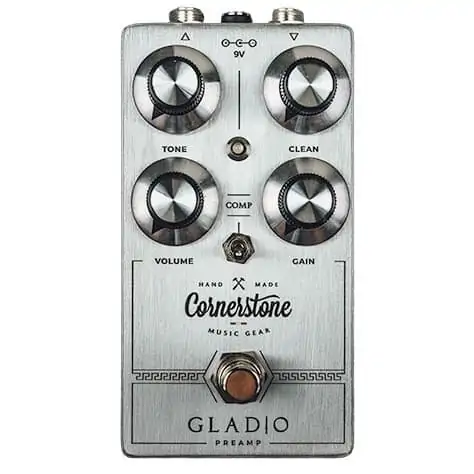
The original Cornestone Gladio, a two-channel Dumble-Style overdrive pedal that quite literally took the electric guitar community by storm in 2020, placed in the top 10 of the most searched pedals in our blog.
The Italian company started 2021 by unveiling a single channel version of that same pedal, the Cornerstone Gladio SC.
Hosted in a compact case, the SC is based on the Gladio’s 1st channel, with the exact same sound and controls, except the new clean knob, which blends the clean signal back in with the overdriven signal, for the joy of those guitarists who are fond of that good ole’ texas-blues tone.
The clean knob affects the tone in three different ways:
– Bottom End: the sound becomes fatter
– Compression: The non-compressed clean sound comes into the mix, and the change in compression is particularly accentuated on the attack.
– Saturation: When the clean sound comes into the mix the final output sound becomes hotter, and it’s able to better push the front end of the amp.
Here’s the first video of the Cornerstone Gladio SC, we added it to our list of the Best D-Style Overdrive Pedals.
Gladio SC (single channel), is designed to offer the same sound of the “big brother” Gladio but in a smaller and compact size.
While the Gladio double channel was inspire by the artists like Robben Ford and Sonny Landreth, the Gladio SC tries to take a step closer to the Steve Ray Vaughan sound, which was achieved using a Dumble amplier too.
The Gladio SC is based on the Gladio 1st channel, with the exact same sound and controls, except the new CLEAN knob. This addition makes a very big dfference, and it’s the one that could actually make the sound be closer to SRV.; the clean signal is taken directly at the input of the pedal and mixed back with the overdriven signal at the output, the CLEAN knob thus manages the volume of the clean signal. with the result of having a “clean layer” on top of the overdrive sound, which help a lot to achieve that texas-blues sound.
A Clean knob like this affects 3 parameters all at once (you can notice their change sweeping the Clean from zero to even a 40% rotation):
– Bottom End: the sound becomes fatter
– Compression: The non-compressed clean sound comes into the mix, and the change in compression is particularly accentuated on the attack.
– Saturation: When the clean sound comes into the mix the final output sound becomes hotter, and it’s able to better push the front end of the amp.























